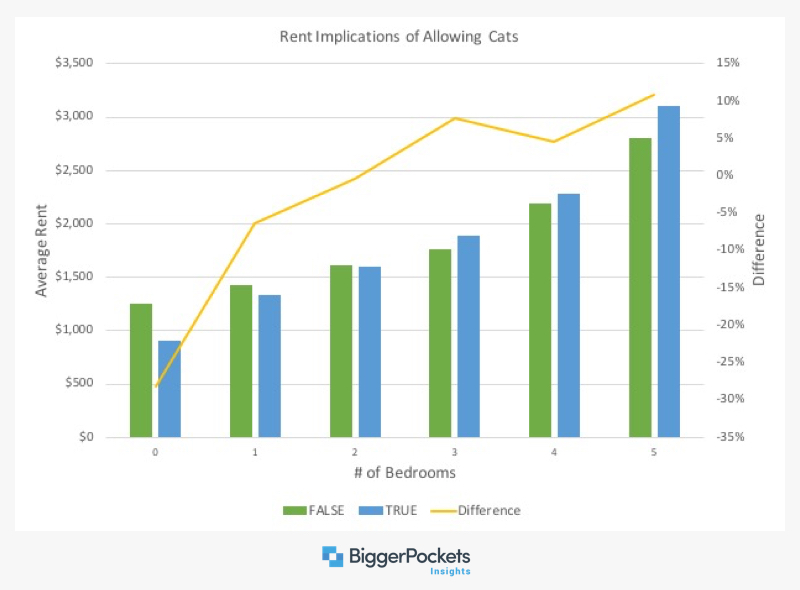As I began looking through some of the rental comp data we’re assembling, I was very intrigued to learn if our dataset could help me answer, once and for all, if allowing pets in a rental property is a worthwhile investment.
So I looked through over 150,000 rental listings on the market in the first half of February 2020 and have come up with some interesting findings about the age-old question of allowing pets. Please note that I am both a pet owner and animal lover—the results below are not meant to stir up the eternal cat versus dog debate (although they might).
Check out my findings below.

Key Findings
Before we get into the data, allow me to make clear one thing: This study does not include pet rent. The data available to me simply show the price of the apartment listed for rent and whether or not allowing dogs or cats is advertised on the listing. So while it would be ideal to add more data to this study in the future, right now we’re looking at the pricing implications of advertising dogs and cats in your rental.
So, what are those implications? Nationally, the net effect of advertising that you permit dogs has a 5 percent increase on gross rent. In dollar terms, that comes out to $81/month or $972/year.
For cats, the national averages tell a different story. Cats, on average, reduce gross rent by 8 percent—which comes out to -$139/month, or a loss of $1,668.

However, as with most things data, the national level averages do not really tell the whole story about what is going on. In fact, the real story is much more complicated and dictated by the type of property under consideration. Read on to see more details on how allowing dogs or cats might affect rent in your property.
Apartments vs. Houses
After seeing the nation-level data chalk up a big loss for allowing cats, and a modest rent increase for allowing dogs, I was curious to see if that pattern held true under closer scrutiny. So, I took a look at how this data changed when I broke it down by the type of property: house vs. apartment.

As you can see from the two tables above, breaking down this dataset by property type changes everything!
For both cats and dogs, the effect on rent prices for apartments is negative, although cats certainly have a more dramatic negative effect on gross rents (-11%) than dogs (-2%). But the overall picture is clear—advertising that pets are allowed in an apartment is associated with lower asking price for rent.
On the flip side, if you’re renting out a house, you may want to consider allowing both types of animals, as allowing a cat is associated with a +7% increase in listed rent price and allowing dogs had a +10% effect.
Number of Bedrooms
The last thing I wanted to understand was how advertising a pro-pet property was affected by the number of bedrooms in the unit, and what I found was very interesting.
For both cats and dogs, the effect on advertising that pets are allowed had a negative effect for smaller units. However, that shifts when the units have greater than or equal to two bedrooms.

The above chart shows three things: average rental price for units that do not allow cats (green), average rent price for units that do allow cats (blue), and the percentage difference between those two rents.
As you can see, the effect on smaller apartments is clear. For studios (0 bedrooms), advertising that cats are allowed reduces average listed rent by 28 percent! That is a huge amount. However, as you go up in the number of bedrooms, that trend reverses itself. At two bedrooms, the difference between permitting and prohibiting cats is 0 percent, and once you get to three bedrooms and up, there is a net-positive effect on gross rent.

The same pattern exists for dogs. It starts negative for studios (-22%), and quickly becomes positive with two bedrooms (+5%) and goes all the way up to +16% for five-bedroom units.
I was curious why this pattern might exist, so I did some quick research and found one possible explanation. According to the American Veterinary Medical Association Survey, in 2018, the amount of family households that own pets was around 66 percent. Meanwhile, the number of non-family households (single renters, roommates, etc.) was only 47 percent.
My best guess is that the demand for pet-friendly rentals is disproportionately tilted toward families, who are likely to want larger units with two-plus bedrooms. But let me know if you have another hypothesis about why this trend might occur.
Conclusion
While this dataset does not tell the entire story about pets (notably, it omits any notion of pet rent, and I make no attempt to estimate the increase in “wear and tear” that allowing pets entails), it does provide some useful information.
- Overall allowing dogs in your rental has a greater positive effect on advertised rental price than allowing cats.
- The benefits of allowing dogs and cats is greater for houses than it is for apartments.
- The benefits of allowing dogs and cats increases as the number of bedrooms in the unit increase.
So, what do you do in your rentals? Personally, I charge a $250 refundable deposit and $25 in pet rent per month per pet. As a pet owner and animal lover, I want to make my rentals pet-friendly, but I also want to make sure that I am not taking a loss by allowing pets. I think the these fees are sufficient to cover the additional “wear and tear” associated with allowing pets.
Follow Hashtags: #LocalSocialPro



 Charles Koenig
Charles Koenig 